It is recommended to be present with someone exhibiting signs of death, to remind him of the statement: “La ilaha illa-l-lah.” This is in accordance with the Prophet’s ﷺ statement: “Instruct your deceased ones (terminally ill) to say “La ilaha illa-l-lah.” [ Source: Muslim.]
Thus when he finally succumbs to death, his eyes should be closed. He should then be covered with a cloth, quickly shrouded and prepared for the funeral prayer, and finally buried.
Bathing, shrouding, carrying, praying over and burying the deceased is fardh kifayah (a collective obligation); when enough people do this obligation, the remaining people are relieved of the sin of not performing it.
1- It is important to choose, for the purpose of bathing the deceased, someone that is trusted, just and knowledgeable about the rulings of the funeral bath.
2- Priority is given to the person appointed or entrusted by the deceased (before his death), then the relatives according to their closeness, on the condition that such a person knows the rulings of the bath; otherwise a more knowledgeable person is chosen for the task.
3- A man bathes men and a woman bathes women, and any of a married couple can bathe the other. This is due to the Prophet’s ﷺ statement to A’ishah (may Allah be pleased with her): “You would not be harmed if you were to die before me, as I would wash you, shroud you, pray over you and thereafter bury you.” [ Source: Ibn Majah.]
A man or woman can bathe children below the age of seven; but it is forbidden for any Muslim – male or female – to bathe an unbeliever, carry his remains to the funeral, shroud or offer funeral prayer over him, even if this unbeliever is a close relative, such as his father.
4- A martyr who died during a battle is not to be bathed, shrouded or prayed on, but he should be buried in the clothes in which he died.
5- When an aborted fetus – a child that is born of its mother before complete formation, male or female– reaches four months, it is to be bathed, shrouded, prayed over and buried, because after four months it has become a human being.
6- The water used to wash the deceased’s body must be pure and legitimate, and the deceased must be bathed in a covered place, just as the presence of anybody not having any business with the bathing process is to be prevented.
1- The deceased is placed on a bed for the bathing, then the parts of his body that should be concealed are covered with a cloth, over his clothes. His clothes are then removed. The deceased should be protected from the eyes (sights of people) by bathing him in a closed room or the like.
2- It is recommended for the person who bathes the deceased to wrap a piece of cloth over (i.e. cover) his hands during the procedure.
3- The person raises the deceased to a near sitting posture, he then massages and presses his stomach. Thereafter, he cleanses the private parts (frontal and the anus), thus removing any impurity that might be on either of them.
4- He makes the intention for the ritual bath and then says “Bismillah”.
5- He performs ablution for the deceased just like that for Salat; except for rinsing the mouth or putting water in the nose, where wiping over the mouth and nose suffices.
6- The head of the deceased and his beard are washed with water containing sidr (Sidr is the name of a lotus tree; “sidr water” means the water to which sidr leaves have been added), soap or other things like them.
7- He washes the right side, followed by the left, then the rest of the body.
8- It is preferred to add camphor to the water for the last round of bathing.
9- The deceased is then dried.
10- The hair of the female is plaited and brought together behind her.
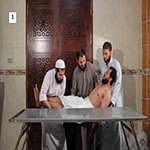 The Deceased is Placed on the Special Bed Used for Washing Him.
The Deceased is Placed on the Special Bed Used for Washing Him.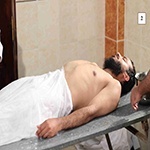 The Head of the Deceased Being Raised
The Head of the Deceased Being Raised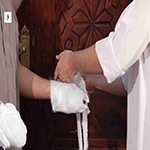 The One Performing the Washing Wraps a Cloth Around His Hand.
The One Performing the Washing Wraps a Cloth Around His Hand. 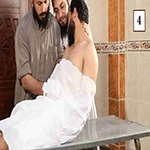 His Stomach Being Pressed
His Stomach Being Pressed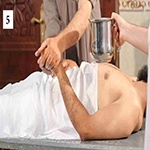 He Performs Wudu’ for the Deceased like the Normal Wudu’ for Salah.
He Performs Wudu’ for the Deceased like the Normal Wudu’ for Salah.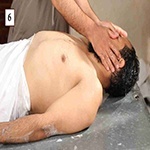 He Washes the Head and Beard of the Deceased with Water and Leaves of the Lotus Tree.
He Washes the Head and Beard of the Deceased with Water and Leaves of the Lotus Tree.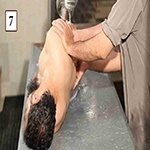 He Washes the Right side then the Left.
He Washes the Right side then the Left.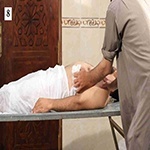 Drying the Deceased
Drying the Deceased- The obligation is to wash once if cleanliness is achieved by that; but it is recommended to wash thrice, even if cleanliness is achieved (prior to the third round.)
- If bathing the deceased is difficult due to lack of water, or the corpse is mutilated as a result of fire etc., then a sand ablution (at-tayammum) is preformed for the deceased.
- It is recommended for he who bathes the deceased to take a ritual bath after bathing the deceased.
1- The tradition (Sunnah) is to shroud males with three white wrappers made of cotton and of clothes that will not reveal or describe the body skin, covering the whole body, but with cloth that is not expensive.
The female is shrouded in five pieces of clothing; a loin cloth, head veil, blouse and two wrappers. A male child is to be wrapped in one cloth but three clothes are permissible, while a female child is to be shrouded in a blouse and two wrappers.
2- The three wrappers are brought and these are scented with incense. This is due to the statement of the Prophet ﷺ: “When you scent the deceased[ Perfume the shroud with incense], then make it odd.” [ Source: Ibn Hibban.]
3- These wrappers are separated one above the other, placing in between them mixtures of scents such as amber, camphor, musk and others, except if the deceased is in a state of Ihram, as his cloth is not to be touched with either incense or perfume. This is due to the saying of the Prophet ﷺ: “Do not touch him (the man who died in Hajj) with perfume.” [ Source: Al-Bukhari.]
4- The deceased is placed lying on his back on these wrappers, then the top cloth is picked up from the left side, pulled over him and tucked under his right side, then the right portion is similarly tucked under his left. The second and third wrappers are treated in the same way. Thereafter the extra length of wrapper is pulled together above his head, and the shroud is bound with strips of cloth so that the wrappers won’t fall apart. The strips are to be loosened during burial.
5- The obligation is to cover the entire body of the deceased. However if what is available is a short cloth that is not sufficient to cover the whole body, then his head is covered and his feet are covered with idhkhir’ [ A plant with a a fragrant odor.] (a plant with a sweet scent). This is evidenced by Khabbab’s , statement when narrating about the shrouding of Mus’ab bn Umair ,: “The Prophet ﷺ ordered us to cover his head and to place on his feet some idhkhir.” [ Source: Al-Bukhari.]
6- The person who dies while in a state of ihram (on pilgrimage) will be buried in his two-piece ihram garment and the head of a male pilgrim is not to be covered. The Prophet ﷺ said: “Wash him with water containing sidr, shroud him in a two-piece cloth, do not use al-‘Anut[ An oil which is mixed for the shrouds of the deceased.] (a perfume) on him and do not veil his head[ Do not cover his head.], for he will be raised on the Resurrection Day while saying at-Talbiyah.[ Saying: Labbaykallahumma Labbayk.]” [ Source: Al-Bukhari.]
Read about the purification in islam
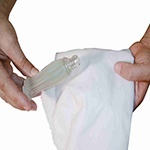 Placing fragrant oil on the shrouds
Placing fragrant oil on the shrouds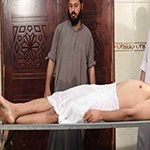 The corpse is placed on its back
The corpse is placed on its back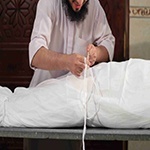 Covering the entire body
Covering the entire body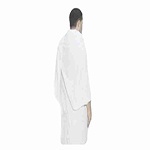
1- Standing if possible.
2- Saying four takbeers.
3- Reciting suratu al-Fatiha.
4- Sending blessings upon the Prophet (may the peace and blessings of Allah be upon him.)
5- Praying for the deceased.
6- Performing the aforementioned in the stated sequence.
7- Saying at-Tasleem.
1- Saying “A’udhu billahi…” before recitation.
2- Supplicating for himself and other Muslims.
3- Reading silently.
4- Making several rows in the congregation, such as three or more.
In case the deceased is a man, the Imam stands at his head, but in case the deceased is a woman, he stands at the middle portion. The followers stand behind the Imam as in all prayers, then the Imam says four Takbeers as follows:
1- He says the first takbeer, and that is the initiating takbeer, followed by “Al-Isti‘adha” and “Bismillahir-Rahamanir Raheem”, but he does not say “al-Istiftah” (the invocation said when starting Salat), then he recites al-Fatihah.
2- He says the second takbeer and then sends blessings on the Prophet in the manner described in the last at-Tashahud.
3- He says the third takbeer, and then he prays for the deceased, himself and other Muslims. Some of the supplications include:
“ Allahummaghfir lahu warhamhu wa ‘aafihi wa‘af ‘anhu, wa akrim nuzulahu wa wassi’ madkhalau waghsilhu bil maa’ wathalji wal barad; wa naqqihi minal khataaya kama naqqaita-th-thawbal abyada minad- danasi. Wa abdilhu daaran khairan min daarihi, wa ahlan khairan min ahlihi, wa zawjan khairan min zawjihi, wa adkhilhul jannata, wa a‘idhu min ‘adhaabilqabri [aw min ‘adhaa bin-naar.]” [ Source: Muslim.]
Meaning: “Oh Allah, forgive him, have mercy on him, grant him respite and pardon him. Be generous to him in his abode, cause his entrance to be wide, and wash him with water, snow and albarad (ice). Cleanse him of his transgressions as you cleanse a white cloth of stains. Grant him an abode better than his abode, a family better than his family and a wife better than his wife. Take him into Paradise and protect him from the punishment of the grave [or from the punishment of Hellfire.]” If the deceased is a female, he changes the pronouns in the prayer to the feminine.
If the deceased is a baby or an aborted foetus [ A miscarried baby.], he is to say: “Allahummaj‘alhu dhakharan liwaalidaihi, wa faratan[ faratan means forerunner.] wa ajran wa shafee‘an mujaaban. Allahumma thaqil bihi mowazeenahoma wa a’atham bihi ajorahoma wa alhiq-hu bisalihi salafi lamumineen wajalhu fi kafalati ibraheem waqihi birahmatika ‘athaba aljaheem.” [ Source: Al-Bukhari.]
Meaning: “Oh Allah, make him a treasure for his parents, a forerunner, a cause of reward and an intercessor whose prayer is answered. Oh Allah, make this (loss) make their (the parents) scales heavy, and make their reward great, and make him be with the righteous believers. And make him under the care of Ibraheem, and protect him, due to Your Mercy, from the punishment of the hell fire.”
4-He says the fourth takbeer and keeps mute for a while, thereafter, he says at-Tasleem only to hisright, or he says the usual two tasleems.
.jpg)
After the funeral Salat has ended, it is Sunnah to hasten to carry the deceased to his grave. It is recommended for the people following the funeral procession to take part in carrying the deceased. Also, it is recommended for the person who places the deceased into his grave to say “Bismillahi wa ‘ala millati rasulillahi.” [ Source: At-Tirmidhi.] Meaning: “In the name of Allah and on the path of the Messenger of Allah.” Following that he places him in al-lahd[ To first dig the grave down straight , in firm soil, then dig a pocket in the direction of the Qiblah in order to bury the deceased in it.] with the deceased’s right side down on the earth and his face towards the Qiblah. Thereafter, he loosens the cloth strips binding the shroud, and then the open Lahd is covered with clay soil.
It is recommended for those in attendance to fill both palms with sand and pour it in the grave three times, then the grave is covered up completely with sand. The grave is mounded to the height of one hand span from the earth. Stones and smaller pebbles are placed on it and it is sprayed with water. There is no problem if, on either end or both ends of the grave, a boulder is placed so that it may serve as a sign.
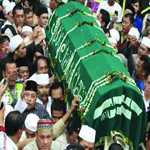 Taking part in carrying the deceased
Taking part in carrying the deceased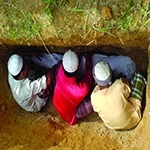 The Lahd Style Grave
The Lahd Style Grave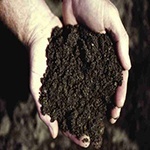 He fills his hands with soil and throws it in the grave.
He fills his hands with soil and throws it in the grave.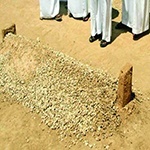 A sign on the grave.
A sign on the grave.It is recommended to commiserate with the family of the deceased, as it helps to console their grieving hearts, alleviate their calamity and encourage them to be patient.
Furthermore condolences can be said in any form that conveys this meaning, e.g. “Lil-lahi maa akhath, wa lahu ma a’ata wa kullu shay’in ‘andahu bi-ajalin musamma fal-tasbir wal-tah-tasib.” [ Source: Al-Bukhari.]
Meaning: “To Allah belongs what He takes and what He gives, and everything with Him is for an appointed time. So endure patiently, and expect the reward of Allah.” Or “’AthamAllahu ajrak wa ahsana ‘aza-ak wa ghufar limaytik.” Meaning: “May Allah make your reward great, make your time of grief beneficial and forgive your deceased.”
It is permissible for the men to visit graveyards with the intention of being reminded of the next life and to offer supplications for the deceased, as evidenced from the Prophet’s ﷺ statement: “I (used to) forbid you from visiting the graves; (but now) do visit them, because such a visit reminds you of the Hereafter.” [ Source: Al-Bukhari.]
Part of what has been reported of supplications during the visitation include: “Assalaamu ‘alaekum dara qawmin mumineen, wa inna insha-Allahu bikum laahiqun.” [ Source: Muslim.] Meaning: “Peace be unto you, O abode of the believers.. Indeed we, if Allah wills, shall surely join you.”
Or: “Assalamu ‘ala ahlid-diyari minal mu’mineen wal muslimeen, wa yarhamullahul mustaqdimeen minnaa walmusta’khireen, wa inna insha Allahu bikum la lahiqun.”[ Source: Muslim.] Meaning: “Peace be unto the inhabitants of this residence from among the Mu’min and the Muslims. May Allah have Mercy upon those among us who left (this world) early and those who shall leave afterwards, and indeed we, if Allah wills, shall surely join you (after a while).”
Or: “As’alul-laha lanaa wa lakumul‘aafiyah.” [ Source: Muslim.] Meaning: “I ask Allah to grant us and you (a state of) well-being.”
It is also permissible if he (the person visiting the graveyard) asks Allah to bless and forgive the dead people.
The Prophet ﷺ said: “If she who wails does not repent before her death, she will be raised on the Day of Resurrection and on her will be a garment of qatiran. [ A shirt from melted bronze.]” [ Source: Muslim.]
The Messenger of Allah ﷺ said: “The person that slaps the cheeks, rips the clothes or calls (to the ways and) in the manner of the era of ignorance, is not part of us.” [ Source: Muslim.]
On the authority of Ibn Abbas t,, it has been reported that: “The Messenger of Allah ﷺ cursed females who visited graves, those who build mosques over graves and those who place lamps (suruj)[ Lanterns.] thereof.” [ Source: At-Tirmidhi.]
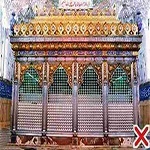 It is not permissible to place lanterns at the grave or to plaster/paint it
It is not permissible to place lanterns at the grave or to plaster/paint itOn the authority of Ja’bir , it has been reported that: “The Messenger of Allah ﷺ forbade (tajsees) [ To paint.] plastering of the grave, for it to be sat upon, and for anything to be built on it.” [ Source: Muslim.]
All these are forms of shirk (association of partners with Allah), if one believes that these might benefit or harm him: Because nobody benefits or harms except Allah (the Most High). He said: “Say (O Muhammad ﷺ: “I possess no power over benefit or harm to myself, except as Allah wills.” (Al-A’raf: 188)
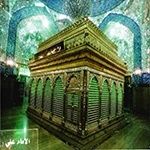 It is not permissible to circumambulate graves.
It is not permissible to circumambulate graves.The Messenger of Allah ﷺ said: “Allah has cursed the Jews and Christians for making the graves of their Prophets as places of worship.” [ Source: Al-Bukhari.]
1- Anyone who misses the funeral Salat may observe it over the deceased before or after the burial. This is according to what was recorded about the case of the woman who used to clean the mosque. The Prophet ﷺ offered the funeral Salat over her grave. [ Source: Al-Bukhari.]
2- It is recommended to prepare food for the deceased’s family; because they (would) have been preoccupied by their calamity and thus be prevented from preparing their food. This is according to a report that someone died from among Ja’far’s household, and then the Prophet ﷺ said: “Prepare food for the household of Ja’far, for they have been met with a matter which has preoccupied them.” [ Source: Abu Dawud.]
 Preparing food for the family of the deceased.
Preparing food for the family of the deceased.3- Crying over the deceased without showing dissatisfaction (with Allah’s decree), without raising one’s voice and without weeping, is permissible. The Prophet ﷺ said when his son, Ibraheem, died: “Indeed, the eye weeps, the heart is saddened, but we do not say anything except that which our Lord is pleased with; indeed we are sad about your demise, O Ibraheem.” [ Source: Al-Bukhari.] A martyr is buried in the clothes in which he was martyred, he will not be bathed nor will funeral Salat be observed over him. This is because it was established that the Prophet ﷺ ordered that the martyrs in the battle of Uhud be buried with their blood on them, and they were not bathed. [ Source: Al-Bukhari.]
4- When a pilgrim dies during Hajj or Umrah, he is bathed, but not perfumed; his head is not covered and the funeral Salat is observed over him. This is due to what was established concerning what the Prophet ﷺ said with regards to the man who died while on Hajj: “Bathe him with water and sidr, shroud him in two clothes and do not perfume him nor cover his head, for he will be raised on the Day of Resurrection saying the talbiyah.” [ Source: Al-Bukhari.]
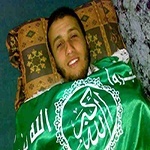 The martyr is buried in his clothes.
The martyr is buried in his clothes.